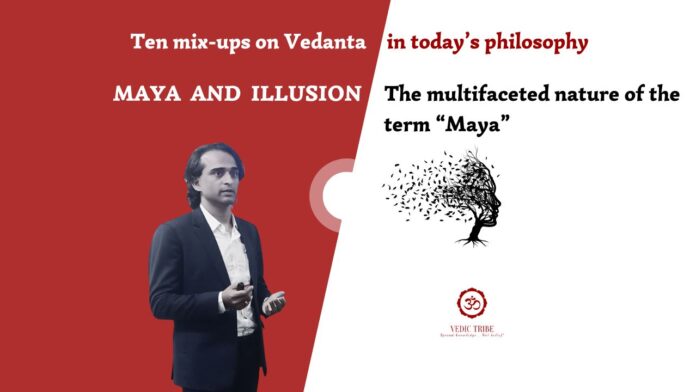The Multifaceted Nature of the term “Maya”
In the previous article, we discussed how the term Theist is not sufficient to explain the term Astika. In this article, we will discuss another inadequate term “illusion” to explain the term “Maya”.
The term “Maya” is often misunderstood as simply meaning “illusion.” While it does carry this connotation, it is a much richer and more complex concept in Vedic philosophy.
In Vedic literature, Maya is a multifaceted concept that encompasses various meanings:
1. Maya is divine power:
Power of Brahman: Maya is often associated with the divine power of creation, preservation, and destruction of Parabrahman. It is the power through which the Supreme Being (Brahman) manifests the cosmos.
Avatar: It is the same divine power through which Brahman appears among humans (See Bhagavad Gita 4.6)
2. Maya is absolution illusion i.e., non-existent material world:
Ajati Vada: In Ajati Vada of Advaita Vedanta, “Maya” is understood as absolute illusion. I.e., the illusion of the very creation of the material world. It’s a bold philosophy declaring that the cosmos in-principle do not exist at all and our perception is a mere illusion.
Asat: In other words, the material world is absolutely non-existent. In this sub-school, Maya is equated to “Asat” (absolute non- existent).
3. Maya is manifestation – i.e., material world is a mere manifestation:
Vivarta Vada: Sri Shankaracharya’s teaching suggest that the world is “Vivartha” or the manifestation of Parabrahman. E.g. waves of the ocean. These waves are nothing but the ocean itself. But they exist separately & temporarily – showing causal powers in addition to that of the ocean.
Illusion: In the same way the material world is created as the manifestation of Parabrahman – causing an illusion that it exists separately. But like waves of ocean, though seemingly showing distinct attributes, the world exists temporarily and reverts back to the original form of Brahman.
In this sub school of Advaita, “Maya” means “Vivartha” or manifestation.
4. Maya can never be explained – i.e., Material world is indiscernible:
Sad-asad Vilakshana: Advaita scholars after Sri Shankaracharya suggest that the world is neither Sat (existent) nor Asat (non-existent). Rather it is “Sat-Asat Vilakshana”, meaning it in-principle cannot be explained.
Spiritual enquiry: Because the world is neither existent nor non-existent, it is not the subject of spiritual enquiry. Instead, Parabrahman is the subject of such enquiry.
5. Maya is perception – i.e., illusory perception creates the mirage of materiality:
Perception: Some Advaita scholars suggest that only when consciousness performs an illusory perception, the material world appears like a mirage in the desert. When the perception is clear the world no longer exists for the consciousness.
Dirshti-Srishti Vada: This is called Drishti-Srishti vada. In popular culture, there have been attempts to equate this with the interpretations of quantum physics.
6. Maya indicates relativity – i.e., relative nature of material world creates illusion:
Few modern Advaita scholars (including some neo-Vedanta preachers) suggest that though material world is manifestation of Parabrahman, due to its nature of relativity it creates illusion.
7. Maya is the feminine dimension of Parabrahman:
In Shakta and tantra tradition, the term Maya is equated with the feminine dimension of Parabrahman
Key takeaways:
The term “maya” has a varied conations (only few covered in this article) which includes “illusion”. However, the term “illusion” is a tiny bit of the larger idea of “maya”.
In the next article, we will discuss the ninth mix-up – “Religion and Dharma”.
Madhwesh K
Vedic Tribe

